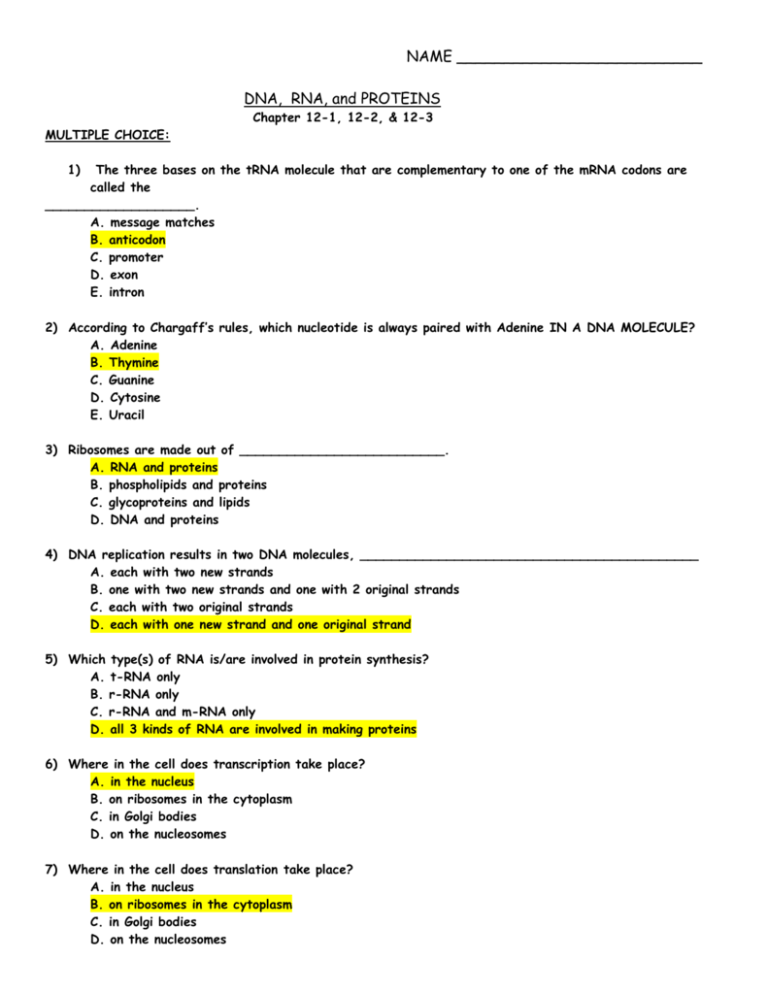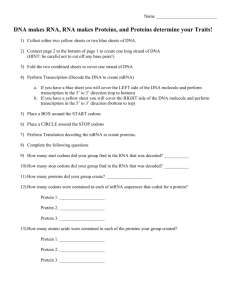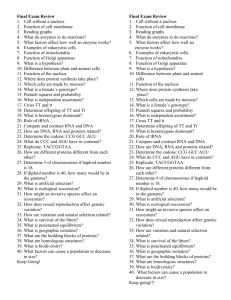DNA 12 123 questions ANSWER KEY
advertisement

NAME __________________________ DNA, RNA, and PROTEINS Chapter 12-1, 12-2, & 12-3 MULTIPLE CHOICE: 1) The three bases on the tRNA molecule that are complementary to one of the mRNA codons are called the ___________________. A. message matches B. anticodon C. promoter D. exon E. intron 2) According to Chargaff’s rules, which nucleotide is always paired with Adenine IN A DNA MOLECULE? A. Adenine B. Thymine C. Guanine D. Cytosine E. Uracil 3) Ribosomes are made out of __________________________. A. RNA and proteins B. phospholipids and proteins C. glycoproteins and lipids D. DNA and proteins 4) DNA replication results in two DNA molecules, ___________________________________________ A. each with two new strands B. one with two new strands and one with 2 original strands C. each with two original strands D. each with one new strand and one original strand 5) Which type(s) of RNA is/are involved in protein synthesis? A. t-RNA only B. r-RNA only C. r-RNA and m-RNA only D. all 3 kinds of RNA are involved in making proteins 6) Where in the cell does transcription take place? A. in the nucleus B. on ribosomes in the cytoplasm C. in Golgi bodies D. on the nucleosomes 7) Where in the cell does translation take place? A. in the nucleus B. on ribosomes in the cytoplasm C. in Golgi bodies D. on the nucleosomes 8) DNA wraps around histones to form bead-like structures called __________________. A. introns B. exons C. ribosomes D. nucleosomes 9) How many codons are needed to specify THREE AMINO ACIDS? A. 3 B. 6 C. 9 D. 12 10) What did the Hershey-Chase blender experiment help prove? A. DNA is a double helix. B. Pneumonia causes dead mice. C. Histones are made of DNA. D. The genetic material is made of DNA. 11) Many DNA molecules contain sequences called ____________ that are not involved in coding for proteins and are edited out of the complementary RNA molecule copy before it is used. A. exons B. introns C. nucleosomes D. anticodons 12) The molecule that caused transformation in Griffith’s pneumonia/mouse experiment was ______________. A. DNA B. a bacteriophage C. a protein D. RNA 13) Nitrogen bases with only 1 ring are called ____________________. A. nucleosomes B. purines C. pyrimidines D. histones 14) The process of making a DNA copy of a DNA molecule (DNA DNA) is called ____________________ A. transcription B. translation C. replication 15) The process of making a complementary RNA message from a DNA code (DNA RNA) is called _______ A. transcription B. translation C. replication Use words from the word bank to match the following: (You can use them MORE THAN ONCE!) messenger-RNA transfer-RNA ribosomal-RNA 16) ________mRNA____________ Carries the DNA code from nucleus to cytoplasm 17) _______rRNA____________ Made by the nucleolus 18) _______tRNA____________ Adds the correct amino acid to the growing protein chain 19) _______rRNA____________ Combines with proteins to form ribosomes 20) _______mRNA____________ Has a CODON region 21) _______tRNA____________ Has an ANTICODON region 22) _______tRNA____________ 23) _______mRNA___________ 24) _______rRNA____________ COMPARE AND CONTRAST CHROMATIN 25) long and thin (not visible) CHROMOSOMES 26) condensed and coiled 27) non-diving cell 28) dividing cell (mitosis) – DNA replicates in preparation to divide What are DNA/proteins doing? Type of cell seen in? COMPARE AND CONTRAST: DNA 29) Double stranded RNA 30) single stranded 31) deoxyribose 32) ribose 33) A, T, C, G 34) A, U, C, G 35) Uracil 36) Thymine 37) Nucleus (mainly) 38) Nucleus and ribosomes (in the cytoplasm) Double / Single stranded? Sugar used? List all nitrogen bases it has Which nitrogen base is missing? Location in cell? INTRON 39) They are both pieces of pre-mRNA EXON HOW ARE THEY ALIKE ? What happens to it? 40) removed before leaving the nucleus 41) Kept as final mRNA copy and leaves the nucleus (are “expressed”) SHORT ANSWER: Name the 3 parts of a nucleotide molecule: ____phosphate_______ ___ 5-carbon sugar_____ _____nitrogenous base______ THINK ABOUT IT: Use what you know about heat and enzymes. (Chapter 1) Why do you think heating the lethal pneumonia bacteria in Griffith’s experiment killed them? _because heats causes the proteins to unravel (lose their shape) and no longer function__________ USING ANALOGIES: If a double helix is compared to a “twisted ladder”, which would the following represent? Sides of the ladder ? ____phosphates and sugar backbone__________________ Rungs of ladder ? ________nitrogen bases_______________________ Glue in the middle that holds the ladder together? _____hydrogen bonds______________








